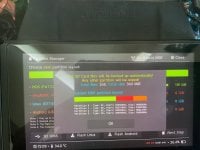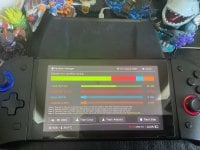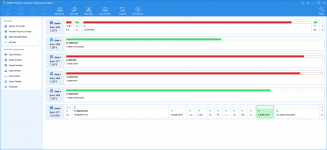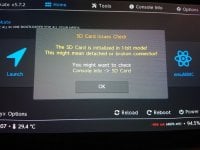// Android Vendor partition.
memcpy(gpt->entries[gpt_idx].type_guid, android_part_guid, 16);
se_gen_prng128(random_number);
memcpy(gpt->entries[gpt_idx].part_guid, random_number, 16);
gpt->entries[gpt_idx].lba_start = curr_part_lba;
gpt->entries[gpt_idx].lba_end = curr_part_lba + 0x200000 - 1; // 1GB.
memcpy(gpt->entries[gpt_idx].name, (char[]) { 'v', 0, 'e', 0, 'n', 0, 'd', 0, 'o', 0, 'r', 0 }, 12);
sdmmc_storage_write(&sd_storage, curr_part_lba, 0x800, (void *)SDMMC_UPPER_BUFFER); // Clear the first 1MB.
curr_part_lba += 0x200000;
gpt_idx++;
// Android System partition.
memcpy(gpt->entries[gpt_idx].type_guid, android_part_guid, 16);
se_gen_prng128(random_number);
memcpy(gpt->entries[gpt_idx].part_guid, random_number, 16);
gpt->entries[gpt_idx].lba_start = curr_part_lba;
gpt->entries[gpt_idx].lba_end = curr_part_lba + 0x400000 - 1; // 2GB.
memcpy(gpt->entries[gpt_idx].name, (char[]) { 'A', 0, 'P', 0, 'P', 0 }, 6);
sdmmc_storage_write(&sd_storage, curr_part_lba, 0x800, (void *)SDMMC_UPPER_BUFFER); // Clear the first 1MB.
curr_part_lba += 0x400000;
gpt_idx++;
// Android Linux Kernel partition.
memcpy(gpt->entries[gpt_idx].type_guid, android_part_guid, 16);
se_gen_prng128(random_number);
memcpy(gpt->entries[gpt_idx].part_guid, random_number, 16);
gpt->entries[gpt_idx].lba_start = curr_part_lba;
gpt->entries[gpt_idx].lba_end = curr_part_lba + 0x10000 - 1; // 32MB.
memcpy(gpt->entries[gpt_idx].name, (char[]) { 'L', 0, 'N', 0, 'X', 0 }, 6);
sdmmc_storage_write(&sd_storage, curr_part_lba, 0x800, (void *)SDMMC_UPPER_BUFFER); // Clear the first 1MB.
curr_part_lba += 0x10000;
gpt_idx++;
// Android Recovery partition.
memcpy(gpt->entries[gpt_idx].type_guid, android_part_guid, 16);
se_gen_prng128(random_number);
memcpy(gpt->entries[gpt_idx].part_guid, random_number, 16);
gpt->entries[gpt_idx].lba_start = curr_part_lba;
gpt->entries[gpt_idx].lba_end = curr_part_lba + 0x20000 - 1; // 64MB.
memcpy(gpt->entries[gpt_idx].name, (char[]) { 'S', 0, 'O', 0, 'S', 0 }, 6);
sdmmc_storage_write(&sd_storage, curr_part_lba, 0x800, (void *)SDMMC_UPPER_BUFFER); // Clear the first 1MB.
curr_part_lba += 0x20000;
gpt_idx++;
// Android Device Tree Reference partition.
memcpy(gpt->entries[gpt_idx].type_guid, android_part_guid, 16);
se_gen_prng128(random_number);
memcpy(gpt->entries[gpt_idx].part_guid, random_number, 16);
gpt->entries[gpt_idx].lba_start = curr_part_lba;
gpt->entries[gpt_idx].lba_end = curr_part_lba + 0x800 - 1; // 1MB.
memcpy(gpt->entries[gpt_idx].name, (char[]) { 'D', 0, 'T', 0, 'B', 0 }, 6);
sdmmc_storage_write(&sd_storage, curr_part_lba, 0x800, (void *)SDMMC_UPPER_BUFFER); // Clear the first 1MB.
curr_part_lba += 0x800;
gpt_idx++;
// Android Encryption partition.
memcpy(gpt->entries[gpt_idx].type_guid, android_part_guid, 16);
se_gen_prng128(random_number);
memcpy(gpt->entries[gpt_idx].part_guid, random_number, 16);
gpt->entries[gpt_idx].lba_start = curr_part_lba;
gpt->entries[gpt_idx].lba_end = curr_part_lba + 0x8000 - 1; // 16MB.
memcpy(gpt->entries[gpt_idx].name, (char[]) { 'M', 0, 'D', 0, 'A', 0 }, 6);
sdmmc_storage_write(&sd_storage, curr_part_lba, 0x8000, (void *)SDMMC_UPPER_BUFFER); // Clear 16MB.
curr_part_lba += 0x8000;
gpt_idx++;
// Android Cache partition.
memcpy(gpt->entries[gpt_idx].type_guid, android_part_guid, 16);
se_gen_prng128(random_number);
memcpy(gpt->entries[gpt_idx].part_guid, random_number, 16);
gpt->entries[gpt_idx].lba_start = curr_part_lba;
gpt->entries[gpt_idx].lba_end = curr_part_lba + 0x15E000 - 1; // 700MB.
memcpy(gpt->entries[gpt_idx].name, (char[]) { 'C', 0, 'A', 0, 'C', 0 }, 6);
sdmmc_storage_write(&sd_storage, curr_part_lba, 0x800, (void *)SDMMC_UPPER_BUFFER); // Clear the first 1MB.
curr_part_lba += 0x15E000;
gpt_idx++;
// Android Misc partition.
memcpy(gpt->entries[gpt_idx].type_guid, android_part_guid, 16);
se_gen_prng128(random_number);
memcpy(gpt->entries[gpt_idx].part_guid, random_number, 16);
gpt->entries[gpt_idx].lba_start = curr_part_lba;
gpt->entries[gpt_idx].lba_end = curr_part_lba + 0x1800 - 1; // 3MB.
memcpy(gpt->entries[gpt_idx].name, (char[]) { 'M', 0, 'S', 0, 'C', 0 }, 6);
sdmmc_storage_write(&sd_storage, curr_part_lba, 0x800, (void *)SDMMC_UPPER_BUFFER); // Clear the first 1MB.
curr_part_lba += 0x1800;
gpt_idx++;
// Android Userdata partition.
u32 user_size = (part_info.and_size << 11) - 0x798000; // Subtract the other partitions (3888MB).
if (!part_info.emu_size)
user_size -= 0x800; // Reserve 1MB.
memcpy(gpt->entries[gpt_idx].type_guid, android_part_guid, 16);
se_gen_prng128(random_number);
memcpy(gpt->entries[gpt_idx].part_guid, random_number, 16);
gpt->entries[gpt_idx].lba_start = curr_part_lba;
gpt->entries[gpt_idx].lba_end = curr_part_lba + user_size - 1;
memcpy(gpt->entries[gpt_idx].name, (char[]) { 'U', 0, 'D', 0, 'A', 0 }, 6);
sdmmc_storage_write(&sd_storage, curr_part_lba, 0x800, (void *)SDMMC_UPPER_BUFFER); // Clear the first 1MB.
curr_part_lba += user_size;
gpt_idx++;









